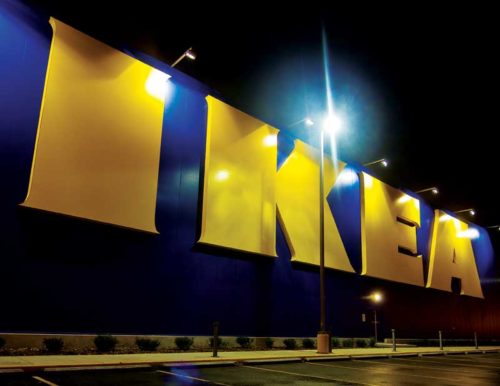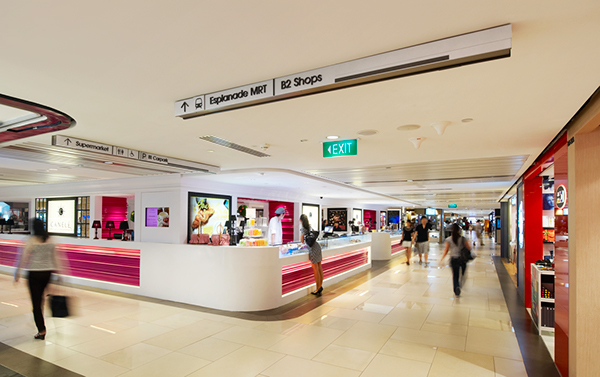
The term ‘wayfinding’ has come a long way since Kevin Lynch first used it in an architectural context in his 1960 book, The Image of the City, where he defined it as the consistent organization of sensory clues in the external environment. In 1984, Romedi Passini’s book, Wayfinding in Architecture, expanded upon this definition to encompass visual graphics, tactile surfaces and audible communications.
凯文·林琦在1960年出版的《城市形象》一书中第一次将‘导视’一词用于建筑环境,他将其定义为户外环境中连贯系统的感官线索,自此导视系统经历了漫长的发展期。1984年,洛米堤·帕西尼的《建筑导视》一书中,对该词的定义进行了扩展,称它还包含有视觉图文、触觉表面以及语音通讯的效果。
Wayfinding through the use of signs has grown dramatically as a field over the past 30 years or so, as part of the profession of environmental graphic design (EGD). There is now considerable wayfinding expertise available when planning airports, hospitals, office buildings and college campuses, among other facilities, validated by educational programs, seminars and books.
导视系统在标识中作为环境图文设计(EGD)专业的一部分,在过去约30年里发展地非常迅速。现如今,相当多的导视系统专业知识都可以用在规划机场、医院、写字楼、大学校园以及其他设施中,它们都是经过教育项目、研讨会以及书籍验证过的。

Retail wayfinding, however, has defied being channelled into a specific discipline. Rather, wayfinding has been treated as a component of multiple retail-related disciplines, such as visual merchandising, customer experience design, digital signage and mobile engagement, which are all well-entrenched with their own publications, academic studies and professional associations. To understand best practices for wayfinding signs in retail, it is important to understand how each of these disciplines relates to wayfinding.
然而,零售行业导视系统并没有局限于一个特定的学科,相反,它包含多个与零售相关的学科,例如视觉营销、用户体验设计、数字标牌以及移动体验,这些都是由学术研究和专业协会钻研出来的。要想做出最好的零售行业导视标识,理解这些与导视系统相关的学科是非常重要的。
Profitable retailers tend to (a) be meticulous about gathering data and (b) constantly experiment with new approaches to attract customers. Given the complex interplay between merchandising, distribution and promotion, the best-managed retailers have a firm hand on both traditional processes and new innovations.
盈利的零售商都善于收集数据、不断尝试新方法来吸引顾客。在复杂的推销、分销和促销形式相互作用下,最佳管理零售商无论是在传统经营模式下还是在创新形式下,都能够做到游刃有余。

The psychology of shopping
购物心理学
Retail wayfinding begins with the development of a strategy for managing a customer’s in-store experience. In his books Why We Buy (2000) and Call of the Mall (2005), Paco Underhill argued shopping is a cognitive science and sales can be improved by successfully manipulating the physical environment through the planning of stores, placement of displays and use of signs. David Kepron’s 2014 book, Retail (r)Evolution, expanded on the notion of measuring the customer experience by analyzing retail stores as social environments, where the customer seeks entertainment in addition to products.
零售导视系统是在充分了解客户在商铺内的购物体验之后,做出的商铺发展战略。帕科·昂德希尔在《购买理由》(2000)和《呼唤商场》(2005)中提到,购物是一门认知科学,销售额可以通过成功操控商场的物理环境而得到提升,例如商铺规划、产品陈设以及标识应用。大卫·开普拉在其2014年出版的《零售(r)改革》中扩展了客户体验的概念,就是要对把零售商铺作为社会环境进行分析,因为客户除了商品之外,也在寻求其他的娱乐环境。
Store layout
店铺布局
Store planning is deeply rooted in tradition. Supermarkets and departments stores, for example, have used similar planning formulas for decades. Signs, too, have closely conformed to practices honed over many years of experience. The ‘racetrack’ and ‘grid’ plans developed by retailers in the 1950s—and the sign practices used to support them—are still in use today, with small modifications.
店铺规划深深根植于传统模式,例如,超市和百货商店使用相似的规划模式已经有几十年的时间了,同样,标识也被传统模式禁锢了许多年。20世纪50年代零售商设计的‘赛马式’和‘网格’式规划、以及在其基础上制作的标识,至今仍在使用,只是稍稍做了修改。
Some companies have grown famous for breaking traditional store layout models and redefining the role of signs to support them, but tradition and experience still play important roles in how people shop. One area where the use of signs has grown, even in traditional plans, has been the installation of brand-specific product displays as visual cues in key areas of the store to attract attention.
一些公司已经打破了传统店面布局模式,并重新定义标识形式来作为依托,但是传统布局模式还是会影响人们的购物体验。如果一个地方的标识模式有所改进,即使还是在传统模式基础上改进,也可以成为产品展示中吸引人的关键之处。

Early in its history, Ikea broke away from store planning traditions with a format that combined practices from showrooms, supermarkets and warehouses. Its signs were also revolutionary, adopting graphic approaches and typography from transportation facilities like airports and train stations and applying them to a retail environment.
在其早期发展历史中,宜家打破传统店铺规划模式,将展厅、超市和仓库结合在一起进行规划。与之配套的标识也经历了变革之路,采用交通设施的图文排印模式,如机场、火车站,然后将其应用到零售环境中。
Another major retail innovation has been the use of a hierarchy of signs and displays to visually break a store into components, from large departments to specific product brands. While this trend started in smaller convenience stores and pharmacies, it is now becoming a key strategy in larger apparel and houseware stores.
零售业另一个主要的创新是通过使用标识和显示屏将一个商铺分解为几个组成部分,从大型部门到特定产品品牌。尽管这种趋势始于小便利店和药店,但是现在已经成为大型服装店和家居用品店的关键营销策略了。
A final trend has been the ‘store-in-a-store’ strategy, whereby a major product brand is represented with a pavilion or entire section of a shop, with its own branding, fixtures and displays. Already popular in department stores for some time, this trend has expanded to other retail spaces.
最新发展趋势是‘店中店’策略,即商铺主打产品有一个专门的品牌馆,有自己的标识、固定装置和展示器材。这种趋势在百货商店内流行了一段时间后,已经蔓延到了其他零售区域了。
Experience design
体验设计
The term ‘experience design’ was first used in the 1999 book The Experience Economy, by B. Joseph Pine II and James H. Gilmore, to explain how companies that once simply created products or offered services are now packaging entire experiences for their customers. Today, business and design consultancies that specialize in experience design have transformed many retail environments.
‘体验设计’一词第一次出现在1999年出版的《体验经济》,作者是约瑟夫·派因二世和詹姆斯·吉尔默,解释了企业以前是如何制作产品或提供服务,而如今却是提供完整的客户体验。现如今,企业和设计顾问公司都是专门从事有关零售环境的体验式设计。
One area where experience design has had an enormous impact is reinforcing consistency of nomenclature, terminology and imagery between retailers’ wayfinding signs, marketing materials and websites. Indeed, this has become a core strategy for retailers to improve their overall appeal to customers.
体验设计对零售领域影响较大的是,加强了导视标识、营销材料及其网站的命名法、术语化、形象化。事实上,这已经成为零售商提升整体吸引力的核心战略了。
Approximately five years ago, for example, Walmart undertook complete renovations based on an experience analysis by Lippincott, a creative consultancy. Improvements were made to everything from interior signs to website formatting, resulting in a seven per cent increase in store traffic among higher-income customers.
例如,大约五年前,沃尔玛在Lippincott创新性顾问公司体验分析的基础上进行了彻底的翻新。从室内标识到网站格式都做了改进,最终其客流量比以往增加了百分之七。

Similarly, in 2008, Canada’s Toronto-Dominion (TD) Bank converted the Commerce Bank branches it had acquired in the U.S., with the assistance of Toronto-based EGD firm Shikatani Lacroix. The project focused on developing specific ‘touchpoints’ that would have the biggest impact on the customer experience, including modular systems for marketing financial products that closely aligned with the branches’ window frames, as well as illuminated signs at the service desk, automated teller machines (ATMs) and lobby, all managed so as to minimize clutter. Newer locations also featured greater integration of digital signage into the architecture.
同样,在2008年,加拿大多伦多道明(TD)银行在多伦多EGD公司Shikatani Lacroix的协助下,转变了其在美国的商业银行分支机构的经营模式。该项目致力于开发特定的‘接触点’,即能够最大程度影响客户体验的设备,包括将营销金融产品的模块化系统紧凑地放置于窗边,还有服务台的照明广告牌、自动柜员机(ATM)和大堂都做了改进,将整体混乱度将为最低。新空出来的地方也安装上了更大的集成性数字标牌。
Effective signs
有效标识
For many years, signs were considered the most disposable components of retail stores. They were made with inexpensive materials and changed out with minimal thought given to their scale, clutter or impact beyond the immediately obvious need to identify an area of the store.
多年来,标识被认为是零售商铺最易支配的组成元素。它们都是用廉价的材料做成给定尺寸需求的标识,然后将其安装在能够识别到商铺的位置。
With recent efforts to improve the customer experience, many retailers now see signs as an important investment, worthy of the same care as other in-store fixtures. This has led to improvements in a number of areas:
许多零售商最近都在努力改善客户体验,他们现在将标识看做是一项重要的投资,就像商铺内其他设备同等重要。这对标识的许多方面都有很深的影响:
Legibility
易读性
Many store designs now reflect the importance of legible signs, to the point where modelling software is used to preview and analyze customers’ viewing ‘corridors’ before an actual store is built. Legibility is achieved through a combination of typeface, scale and contrast.
现在许多商铺的标识设计都反映出清晰度的重要性,在实际商铺被建成之前,建模软件用来预览和分析客户查看产品的‘走廊’。易读性是通过字型、比例以及对照物来实现的。
Dimensionality
维度
Retailers are finding opportunities to use channel letters, projecting signs, awnings and other traditional outdoor signs inside their stores. By replacing typically ‘flat’ indoor signs, they help make the interiors look more like storefronts or street fairs.
零售商正在研究他们商铺能够使用槽形发光字、突出标识、帆布篷以及其他传统户外标识的地方。与普通的‘平面’室内标识相比,它们使得内饰看起来更像店面或街头集市。
Illumination
照明
Similarly, the same light-emitting diodes (LEDs) used for exterior illumination are finding their way inside stores. One leading trend has been the use of cove and soffit lighting to illuminate indoor signs, particularly those identifying the departments within a store.
同样,用于外部照明的发光二极管(LED)也可以用于室内照明。用于室内照明的拱形灯是主流发展趋势,尤其是用于商铺内那些易于辨认的部门。
Modularity and material quality
模块化及材料质量
Modular sign systems have always been integral to stores, but now some of them are becoming more closely linked to merchandising fixtures, to the point where they become the same system. This approach tends to boost the quality of store signs by matching them to the same material standards as fixtures.
模块化标识系统已经成为商铺不可或缺的一部分了,但是现在他们中的一些人将其与销售设备紧密的联系在一起,想要做成同一个系统。通过匹配相同标准的材料来制作标识,会提高商铺标识的质量。

Window displays
橱窗展示
Successful store navigation does not rely on signs alone, but rather brings architecture and displays together to create a complete environment that both directs and informs customers. Window displays have become more common, for example, because store architecture has become more ‘transparent,’ with larger glass panels to decorate.
成功的商铺导航系统并不依赖于标识本身,而是将体系结构和显示装置结合在一起,创造出引导顾客的完整环境。例如,橱窗展示越来越普遍,因为商铺的建筑结构都用较大的玻璃面板进行装饰,变得更加地‘透明’。
With the removal of enclosed, ‘boxed’ windows, displays have become a much greater part of overall store design and a primary supporter of wayfinding. Designers use themed window displays as landmarks to entice visitors into a store and to promote sales of specific items. Large-format digital printing, modular panels, illumination, dimensional displays and digital signage can all be integrated to meet these communication demands.
带有可移动封闭式橱窗的商铺,其显示屏已经成为商铺整体设计的重要组成部分,也是导视系统的一个主要形式。设计师用特定主题的橱窗显示屏作为吸引顾客进店的法宝,以此来提高特定产品的销售额。宽幅数码喷印、模块化面板、照明标识、数字标牌都可以满足这些交互式需求。
Visual merchandising
视觉营销
The multi-billion-dollar visual merchandising industry, comprising everything from fixtures to merchandising displays to point-of-purchase (POP) graphics, can be thought of as a sort of central operating system (OS) for retailers, following practices that are sensitive to customers’ actions and psychology. Within this field, retail signage is often categorized at two levels: (a) ‘macro’ signs that identify key areas of a store, are relatively ‘fixed’ and cannot be changed easily; and (b) ‘micro’ POP and promotional signs that are more flexible and adaptable to the ever-changing retail environment.
数千亿美元的视觉营销行业,包含从设备到带有POP图文的销售显示屏,都可以看做是零售商的一套中央操作系统(OS),是根据顾客的实际行为和购买心理设计而成的。在这个领域内,零售标识通常分为两个级别:(a)代表商铺关键区域的‘大’标识,它们一般是固定的,不轻易改变或挪动;(b)小型POP和推广标识则更加灵活,能够适应不断变化的零售环境。
Excellence in retail wayfinding is often achieved through a close correlation between how the macro and micro levels of signs are managed, so as to achieve seamless integration, rather than gaps in consistency and/or quality. One reason today’s visual merchandisers have innovated in this direction is the considerable pressure to compete with online shopping. This is also one of the reasons for the increased use of digital signage.
完美的零售导视系统是将大型、小型标识紧密地结合起来,从而达到无缝衔接的效果,而不是一致性和质量方面的缺失。现如今的业务员在该领域富有创新能力的原因是,他们有与网上购物竞争的巨大压力。这也是增大数字标牌应用的其中一个原因。
Marketing and promotion
推广及宣传
Marketing departments have an outsized impact on wayfinding signs in retail environments. With access to high-quality large-format digital printing, they have worked in recent years to turn promotion into part of the wayfinding process, with large-scale marketing materials integrated into lightboxes, fixtures and windows.
营销部门对零售环境中的导视标识有极大的影响。在高质量宽幅数码喷印技术的作用下,近几年来促销形式已经成为导视系统的组成部分,包括安装在灯箱、固定装置和橱窗上的大规模营销材料。
The growth in large-format printed graphics has also resulted in ‘mergers’ between industries. The packaging and fixtures industries, for example, have combined their efforts to better control how products are displayed in stores, with less need for intervention by in-store personnel. Trade show exhibit fabricators have found new opportunities in the retail sector by developing pop-up stores and branded pavilions.
宽幅喷印图文应用的增长也加剧了行业之间的‘并购’。例如,包装和设备行业相互合作以达到更好的产品展示,减少商铺店员参与的需求。贸易展览制作商在零售行业发现了新的发展机会,就是制作临时概念店和品牌展示馆。
Branded environments
品牌环境
Eva L. Maddox was the first designer to coin the term ‘branded environment’ in reference to the integration of branded communications in EGD. She designed spaces for corporations, universities and hospitals until she retired in February 2016.
伊娃·马德克斯是第一个将‘品牌环境’整合到EGD品牌交流中的设计师。她一直在为企业、大学和医院设计品牌,直到2016年2月退休。
Closely aligned with the aforementioned discipline of experience design, branded environments have evolved with explorations of architecture, materials and space to reinforce corporate and institutional identities. In the retail sector, this evolution has resulted in stores that share design attributes with other types of facilities, including airports, offices and residential buildings. As such, signs and other wayfinding elements for these stores have been specified for greater permanence and tightly integrated with interior decor.
与上述提到的体验设计、品牌环境紧密结合起来的学科知识,已经扩展到了建筑、材料和空间设计领域,以此来加强企业和机构的知名度。在零售行业,这种发展趋势导致商铺和其他类型设施共享同种设计属性,包括机场、办公楼和居民楼。因此,这些商铺的标识和其他导视元素要用特定耐用的室内装饰材料来制作。

Digital signage
数字标牌
In the last decade or so, digital retail technology has grown into a multi-billion-dollar industry unto itself, affecting every aspect of the buying and selling experience. Many retailers have worked to develop proprietary systems that link their websites, inventory logistics and in-store purchasing into one seamless whole.
过去约十年里,数码零售技术本身已经发展成为一个数十亿美元的产业,影响了买卖体验的方方面面。许多零售商已经开发出专有系统,将其网站、仓储物流和店内采购库联系成无缝衔接的整体。
Extending these systems to digital signage, however, has not always been so straightforward. Beyond front-of-store and key ‘landmark’ digital signs, in-store networks have been somewhat difficult to develop because of high upfront costs, along with those for ongoing management.
然而,将这些系统扩展到数字标牌领域的过程并不总是那么容易。与商铺正面标识和关键性数码标识相比,较高的前期成本和不间断的管理使得室内整体标识网络的发展有些困难。
That said, digital signage has made significant headway with content-intensive retailers, including those specializing in electronics and communications products. The next frontier for these systems will be interactive digital signage, whereby customer behaviour and specific purchases will affect on-screen content. Indeed, many retailers believe responsive content will allow them to truly realize the potential value of their investments in digital signage technology.
数字标牌在零售领域已经取得了重大进展,包括那些特制的电子通讯产品。这些系统接下来的发展方向就是交互式数字标牌,即顾客的行为和具体产品的采购都会影响屏幕上的显示内容。事实上,许多零售商都相信,响应式内容让他们真正意识到,投资在数字标牌技术上的潜在价值。








